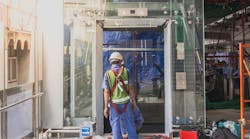The same Internet of Things (IoT) devices that are enabling more granular lighting and HVAC control are now making predictive maintenance easier, cheaper and less labor-intensive for elevators and escalators.
IoT’s technical capabilities let the devices manage large streams of performance data and predict maintenance requirements and impending failures with a fraction of the time and effort it would take a human technician to perform that kind of analysis.
As a result, vertical transportation is embracing the philosophy aircraft engineers have used for years, says Rory Smith, director of strategic development for thyssenkrupp Elevator Americas.
“Pilots radio ahead when they have a problem. If they detect a problem with an oil pump in an engine on a flight from London to Chicago, they can radio ahead and say ‘I need my oil pump replaced when we land,’ and they can change the parts rapidly and put the plane back into service without missing the next flight,” explains Smith. “They have expensive assets and a high cost of failure. Now we can take advantage of that same technology and apply it to assets like elevators and escalators.”
On topic: Smart Building Technology is Changing Facilities Management
So far, IoT implementation for vertical transportation has revealed two key customer camps, according to Jeremy Rainwater, senior vice president of existing installation and modernization for Schindler: people who prize the benefits of improved performance, transparency and new insights, and those who are more focused on cost savings. Today’s IoT-enabled elevators deliver these 10 benefits and more.
1) Monitoring Operating Conditions
Like the IoT devices in other building systems, elevator IoT devices make gathering data simple and effortless. Depending on the elevator manufacturer and model, your IoT-enabled elevator might gather data in any of these areas, according to Charlie Slater, director of field operations at American Testing and Inspection Services:
- Critical safety circuits
- Load weighing
- Number of trips
- Number of door cycles
- Wait times
- Traffic trends
- Ride analysis (acceleration and deceleration, jerk, bumps, vibration)
- Harmonic analysis (the harmonics of the machine, suspension members and guiding members)
2) Predictive Maintenance
The biggest immediate time-saver that IoT data fuels is improving your preventive maintenance schedule and switching to more of a predictive maintenance model. The devices can monitor changes in operating conditions, like heat, friction or noise, and use the changes to predict when the elevator needs maintenance.
(Photo: Technician fix the lift or elevator in railway station of skytrain. Credit: SB7)
“If certain conditions are left unattended, they could result in equipment failure, and in turn cause an unplanned disruption in a building,” explains Daniel Elez, senior vice president of service business for KONE Americas. “IoT is allowing maintenance to become predictive and proactive vs. reactive.”
Keeping track of wear and tear is another useful way to predict when and where maintenance will soon become necessary, adds Smith. That could include door open-close cycles, how long the door takes to close and how much power it draws to do so, how many times the elevator has to relevel, acceleration speeds and even the physical distance the elevator has traveled.
More on this topic: How IoT Devices Enable Predictive Maintenance
“We’re keeping track of door cycles on a per floor basis so that we know which floors have the most use of the doors. No matter what brand, the doors on elevators are the most problematic device because they’re mechanical and they take a lot of abuse,” Smith explains.
“People run into the doors and hold them open when they’re trying to close. We believe there’s a correlation between the amount of abuse and the number of breakdowns and we want to make sure we adjust our maintenance frequency to the doors that get the most use. Now we can quantify it and say ‘Every X number of times the door cycles, we should schedule maintenance,’” he adds.
3) Remote Diagnostics and Troubleshooting
The constant stream of data from the monitoring devices also enables manufacturers and other elevator service professionals to diagnose problems at least partially before they even reach your building, saving valuable on-site time that would otherwise have been wasted on testing and troubleshooting.
BUILDINGS Checklist
Preventative Maintenance
Use this checklist to keep major building systems—HVAC, roofing, plumbing and lighting—in good working order. Get yours here >>
The technician can receive a complete diagnosis with corroborating information and suggested actions ahead of time so that when they reach your building, they can spend all of their time actually fixing the problem, Elez says.
“Without IoT, if it’s noticed that an elevator is out of service, a maintenance company would be contacted to request a service call,” says Slater. “The elevator maintenance company would need to dispatch a mechanic to visit the unit and hopefully diagnose the issue correctly. They may have to order parts and have a return visit to perform the repair. If the diagnosis was incorrect, they would have to start over again. With IoT, the elevator maintenance company knows immediately and probably before the building does that the elevator is out of service.”
4) Real-Time Notifications
IoT devices in elevators may even be able to catch problems before facilities managers or building occupants notice anything is amiss. Remote monitoring and diagnostics can catch budding problems when they start instead of waiting until the elevator is noticeably noisier or drawing a spike in power.
“For example, Schindler can see that an elevator is on the third floor of a building with a switch in the wrong position and can proactively contact the customer to resolve the issue, vs. the customer having to call for service, get in the queue for a technician and have the technician arrive just to find out that a switch needed to be turned,” Rainwater says. “This level of proactive service will help us deliver even better performance and reliability by using data to identify and act on potential issues even before our customers are aware of an issue.”
5) Behavioral Insights
Future elevator IoT devices should be able to gather data on the behavior of users and use that to inform the unit’s behavior, Elez notes: “For example, instead of an unexpected influx of lobby visitors, data can help inform systems when trains arrive nearby or large meetings or conferences are ending, all to be prepared for lots of people arriving or departing a building.”
6) Avoided Downtime
There’s significant value in not having to drop everything to deal with an unexpected elevator or escalator breakdown. Downtime for your vertical transportation should be rare, planned and during off-peak hours.
“Failure prediction is a big goal,” Smith says. “We want elevators to be running a higher percentage of the time, but we also want to have planned downtime. You can’t have 100 percent uptime because you’ll have to take it out of service to provide maintenance, so we want to make sure that the right amount of maintenance is being provided.”
BUILDINGS Podcast
Prescriptive Maintenance: The Next Generation Solution
[podcast]
Preventative maintenance is a crucial component to your facilities systems. Taking this one step further is prescriptive maintenance—or RxM. Listen now >>
The IoT devices are like a computerized version of a resident or escalator mechanic who gets to know the machines through daily use and inspection, Smith adds. Most buildings don’t have that kind of specialized expertise on-site anymore, but the 24/7 monitoring by IoT devices serves as the eyes and ears of whoever is responsible for maintaining a building’s vertical transportation systems.
7) Increased Product Reliability
Manufacturers can use IoT data in-house to improve the innovation process. Something as simple as switching out a part vendor could have sizable effects, positive or negative.
“With machine learning and all of this data, we’re learning which components are strong and which ones are weak so that we can take that and say ‘We’re having a lot of problems with this particular component. Let’s fix that and figure out how we can harden it so it won’t fail,’” Smith says. “We might have a new vendor for a product and we’ll be able to see the results of changing vendors on what appears to be an equal component. IoT ends up being a product improvement and customer satisfaction approach.”
8) Flexible Communication Standards
Facilities teams looking at IoT integration often fear that the equipment is proprietary, Slater says. Sometimes that’s true, but you can avoid being trapped into a long-term maintenance agreement for a system that won’t communicate with other manufacturers by specifying your needs up front.
“Other maintenance companies may be able to integrate – if not fully, then partially – their own IoT systems with the existing equipment of another manufacturer,” Slater says. “There are also steps that can be taken prior to having IoT installed or purchasing a new or modernized elevator or escalator with IoT. For example, hire an elevator inspector or consultant to draft a specification for IoT and ensure the building receives something that most maintenance companies can integrate with.”
9) Less Frequent Replacement
Monitoring equipment constantly and avoiding breakdowns not only lets you avoid emergency service calls, it also may save you money on the actual services performed, Elez says. “Ongoing monitoring of equipment can provide significant cost savings in the long run by upgrading component parts vs. the need for a full-unit replacement due to more extensive damages from a series of issues,” Elez explains. “The ultimate benefit is the smooth flow of people in a facility.”
10) Enabling Better Facilities Management
The falling cost of IoT devices and advances in the cellular technology that the devices use to communicate are making IoT a more realistic investment than ever, Rainwater says.
“Previous technology was limited in its capability and potential, creating a ceiling on innovation,” Rainwater adds. “The latest generation of cellular technology and the ability to use that tech to get massive amounts of information to systems with far more computing power allows us to use IoT as a tool for predictive analytics and predictive maintenance and add future services and apps for building managers.”
Two hand-picked articles to read next:




